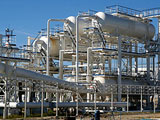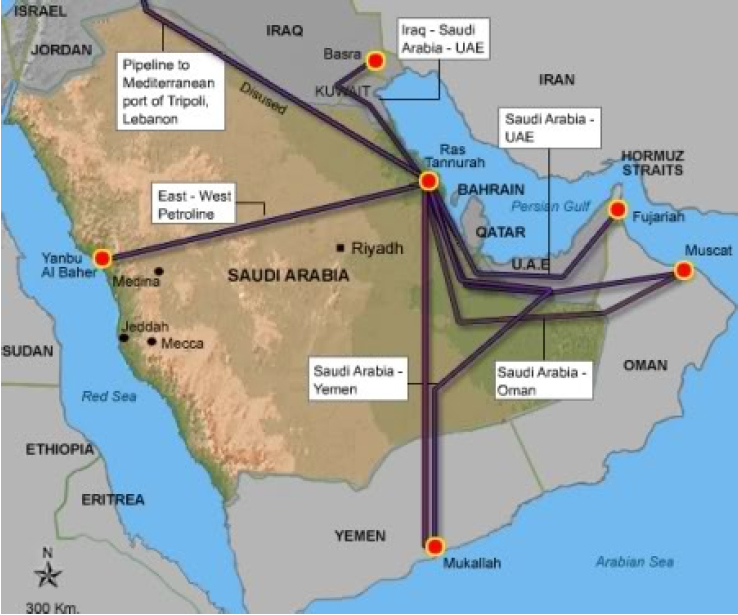Saudi Arabia’s and Turkey’s Pipeline Wars in Yemen and Syria
24 Jun 2016
By Christina Lin for Institut für Strategie- Politik- Sicherheits- und Wirtschaftsberatung (ISPSW)
This article was external pageoriginally publishedcall_made by the external pageInstitut für Strategie- Politik- Sicherheits- und Wirtschaftsberatung (ISPSW)call_made in June 2016.
Abstract
With Saudi Arabia’s and Qatar’s vast energy reserves and Turkey’s NATO-trained military power, this Triumvirate has been backing Islamist groups to overthrow the governments in Syria and Yemen in what appears to be a “backdoor strategy” to build gas and oil pipelines. Turkey is also increasing defense ties with various energy producers and building military bases abroad to access key energy corridors, including the Persian Gulf, Horn of Africa, Caucasus, the Red Sea and the Mediterranean Sea.
Analysis
Saudi Arabia’s pursuit of the war in Yemen, at considerable cost in blood and treasure, is a literal affirmation of the term “backdoor strategy.” However, both the “door” and the actual contours of that strategy remain submerged beneath the murky waters of Mideast politics.
In June 2015, a senior advisor on Yemen in the Netherlands Ministry of Foreign Affairs, Joke Buringa, wrote an article regarding Saudi Arabia’s interest in building an oil pipeline through Yemen. Her piece underscored the energy geopolitics behind Riyadh’s bombing campaign over the past year.
Saudi oil pipeline through Yemen’s Hadramaut
In her article entitled “Divide and Rule: Saudi Arabia, Oil and Yemen,” Buringa revealed that the Saudis fear an Iranian blockade of the Hormuz Strait, and were seeking pipelines through Yemen. This would provide Riyadh with direct access to the Gulf of Aden and the Indian Ocean to reach the Asian market.1
Middle East Eye columnist Nafeez Ahmed, citing a 2008 State Department cable from Wikileaks, has confirmed the Saudi interest in building a pipeline that is “wholly owned, operated and protected by Saudi Arabia, through Hadramawt to a port on the Gulf of Aden.”2
Hadramaut is Yemen’s wealthiest governorate that counts 4 of the 26 million population, 50% of Yemen’s landmass, 80% of its oil exports, a sufficient water supply, and gold reserve worth $4 billion.
When Iran and Oman signed an agreement for a gas pipeline in 2014, this increased Riyadh’s distrust of Oman and increased the attractiveness of the Hadramaut pipeline option in Yemen. In February 2015 when the Houthis took control of the government, Riyadh began its bombing campaign the following month.
Interestingly, according to Buringa, Hadramaut (which is now under the control of al-Qaeda in the Arabia Peninsula or AQAP), is one of the few areas where the Saudi-led coalition didn’t conduct airstrikes. This has left the port and international airport of al-Mukalla in optimal shape. She observed “Saudi Arabia has been delivering arms to al-Qaeda, who is expanding its sphere of influence” and assessed that “those pipelines to Mukalla will probably get there eventually.”
Indeed, Jamestown Foundation’s terrorism analyst Michael Horton concurs Riyadh views AQAP as a useful proxy in its war against the Houthis, which “would mirror the situation in Syria where al-Qaeda affiliate Jabhat al-Nusra has for some time been regarded by Saudi Arabia and other Gulf States as a relatively moderate proxy force” to counter the Assad government.3
Unfortunately, one year of Saudi-led bombing campaign on Yemen has resulted in an empowered al-Qaeda that is establishing a Hadramawt emirate.4
Similarly, Syria’s al-Qaeda branch, al-Nusra, is now establishing an Islamic emirate in northern Syria.5 Syria is also where Saudi Arabia, Qatar, and Turkey are interested in building a gas pipelines to reach the lucrative EU market.
Qatar-Turkey gas pipeline through Syria’s Aleppo
Writing in Armed Forces Journal, Major Rob Taylor joined numerous other pundits in observing that the Syrian civil war is actually a pipeline war over control of energy supply, with Saudi Arabia, Qatar and Turkey needing to remove Assad “so they can control Syria and run their own pipeline through Turkey.”6
“Saudi Arabia and Qatar, as well as al-Qaeda and other groups, are maneuvering to depose Assad and capitalize on their hoped-for Sunni conquest in Damascus. By doing this, they hope to gain a share of control over the ‘new’ Syrian government, and a share in the pipeline wealth.”
The proposed pipeline would traverse Aleppo where Turkey’s Erdogan has been lobbying for a no-fly zone backed by US military power and American tax dollars.
Turkey is also increasing defense ties with various energy producers and building military bases abroad to access key energy corridors. These include natural gas-rich Qatar in the Persian Gulf, Somalia in the Horn of Africa, Georgia in the Caucasus, and Sudan in the Red Sea. It also has troops in oil-rich northern Iraq, northern Cyprus with its offshore gas reserves, and is amassing troops by the Syrian border.7
In December 2015, Turkey announced plans to establish a military base with 3,000 troops in Qatar, followed in January 2016 by plans to establish a military base in Somalia.8 This was preceded by a memorandum for trilateral military cooperation with Georgia and Azerbaijan in May 2015. Azerbaijan supplies gas to Turkey and there are discussions regarding a future Turkish military base in Georgia.9
Also in May 2015 ahead of the Sudanese elections, Turkish warships conducted joint military exercises with Sudan.10 Sudan shares Erdogan’s support for Egypt’s Muslim Brotherhood, and is strategically located in the Red Sea that links maritime trade between Europe and Asia. Since Morsi was ousted in 2013, Cairo-Khartoum ties have deteriorated, and in November 2015 Sudan began a troop buildup by the Egyptian border.11
Along with troops in northern Iraq, northern Cyprus, and along its border with northern Syria, Turkey is building is first aircraft carrier.12 With Riyadh and Doha’s vast energy reserves and Ankara’s NATO-trained military power, this Triumvirate has been backing the al-Nusra led Army of Conquest in northern Syria to overthrow the Syrian government, AGAP to overthrow the Houthis in Yemen, while in Libya, the Muslim Brotherhood-led Libya Dawn is supported by Turkey, Qatar and Sudan.
Jihad in the Mediterranean Sea?
Should Egypt, Libya, Syria and other countries in the Eastern Mediterranean fall to Islamist forces, this would not bode well for maritime commerce in the region.
In 1801, America under President Thomas Jefferson waged the Barbary wars (1801-1805, 1815) with three Ottoman provinces of Algiers, Tunis, Tripoli and an independent Sultanate of Morocco to counter their maritime terrorism in the Mediterranean. These states on North Africa were known as the Barbary States, and they engaged in piracy to collect ransoms and tributes.
After repeated seizure of American merchant ships, holding and enslaving crews for ransom and extorting excessive tribute to the Barbary rulers, Jefferson finally waged war with them and deployed the US Navy over- seas for the first time. The US Marines eventually defeated the Barbary States, which is memorialized in a line of the Marines’ Hymn—“the shores of Tripoli.”
Now the “Barbary” coast of North Africa, Suez Canal, Red Sea and Gulf of Aden are once again facing a return of maritime terrorism with the presence of Islamist groups including ISIS and al-Qaeda.13 With so much focus on freedom of navigation in the South China Sea and France pushing EU for joint patrols, one wonders if France should look closer to the Mediterranean for patrols, and move forward with the EU parliament’s proposed arms embargo on Saudi Arabia that is supporting jihadi groups to destabilize the EU’s southern neighborhood.14
Notes
1 http://web.archive.org/web/20150701113930/http:/www.jokeburinga.com/divide-and-rule-saudi-arabia-oil-and-yemen-3/
2 Nafeez Ahmed, “Saudi war for Yemen oil pipeline is empowering al-Qaeda, IS”, Middle East Eye, 10 February 2016, http://www.middleeasteye.net/essays/saudi-war-yemen-oil-pipeline-empowering-al-qaeda-1386143996
3 Michael Horton, “The Hadramawt: AQAP and the Battle for Yemen’s Wealthiest Governorate”, Terrorism Monitor, Volume 13, Issue 14, 10 July 2015, http://www.jamestown.org/single/?tx_ttnews%5Btt_news%5D=44145tx_ttnews%5BbackPid%5D=7#.V1qu8VdOtSU
4 Bruce Riedel, “Al-Qaida’s Hadramawt emirate”, Brookings Blogs, 12 July2015, http://www.brookings.edu/blogs/markaz/posts/2015/07/12-al-qaeda-yemen-emirate-saudi-riedel
5 Jabbat al Nusra in Syria: An Islamic Emirate for Al-Qaeda, Institute for the Study of War, http://www.understandingwar.org/jabhat-al-nusra-syria-islamic-emirate-al-qaeda; Charles Lister, “Al Qaeda is about to Establish an Emirate in Northern Syria”, Foreign Policy, 4 May 2016, http://foreignpolicy.com/2016/05/04/al-qaeda-is-about-toestablish-an-emirate-in-northern-syria/; Raf Sanchez, “Al Qaeda leader gives blessing for terror group to form own ‘Islamic state’ in Syria”, Telegraph, 8 May 2016, http://www.telegraph.co.uk/news/2016/05/08/al-qaeda-leader-gives-blessing-for-terror-groupto-form-own-isla/
6 Maj. Rob Taylor, “Pipeline politics in Syria”, Armed Forces Journal, 21 March 2014, http://armedforcesjournal.com/pipelinepolitics-in-syria/
7 Dorian Jones, “Turkey Military Masses at Syria Border, but Why?” Voice of America, 13 May 2016, http://www.voanews.com/content/turks-mass-syria-border/3329295.html; “Russia: Turkish troops in Syria for operation against the Kurds”, Associated Press, 13 March 2016, https://www.yahoo.com/news/turkey-declares-24-hour-curfew-mainlykurdish-town-090847152.html?ref=gs
8 “First Turkish military base in Africa to open in Somalia”, Daily Sabah, 19 January 2016, http://www.dailysabah.com/diplomacy/2016/01/19/first-turkish-military-base-in-africa-to-open-in-somalia
9 Joshua Noonan, “Turkey’s military in the Caucasus”, Silk Road Reporter, 9 May 2015, http://www.silkroadreporters.com/2015/05/09/turkey-in-the-caucasus/
10 Morgan Winsor, ‘Turkish Warships Dock in Sudan for Joint Drills Ahead of Sudanese Elections”, International Business Times, 6 April 2016, http://www.ibtimes.com/turkish-warships-dock-sudan-joint-drills-ahead-sudanese-elections-1870978
11 Mohammed Amin, “Ongoing tension between Egypt, Sudan”, Anadolu Agency,1 June 2016, http://aa.com.tr/en/politics/ongoing-tension-between-egypt-sudan/501366
12 Thomas Siebert, “Just what the Middle East Needs: Turkey’s Getting an Aircraft Carrier,” Daily Beast, 1 May 2016, http://www.thedailybeast.com/articles/2016/01/05/just-what-the-middle-east-needs-turkey-s-getting-an-aircraft-carrier.html
13 Niklas Anzinger, “Jihad at Sea-Al Qaeda’s Maritime Front in Yemen”, Center for International Maritime Security, 25 February 2014, http://cimsec.org/jihad-sea-yemen-al-qaedas-new-frontier/9733; Akiva J. lOrenz, “Al Qaeda’s Maritime Threat”, MaritimeTerrorism, 15 April 2007, http://www.maritimeterrorism.com/2007/04/15/al-qaeda’s-maritime-threat/; Ben Farmer, “Isil wants its own navy for attacks on cruise ships in the Mediterranean”, Telegraph, 28 January 2016, http://www.telegraph.co.uk/news/uknews/defence/12128328/Isil-wants-its-own-navy-for-attacks-in-the-Mediterranean.html
14 Eldar Mamedov, “European Parliament Calls for an Arms Embargo against Saudi Arabia”, Lobelog, 1 March 2016, https://lobelog.com/european-parliament-calls-for-an-arms-embargo-against-saudiarabia/; http://www.latimes.com/opinion/op-ed/la-oe-0330-whitson-yemen-strikes-20160330-story.html (Copyright 2016 Asia Times Holdings Limited, a duly registered Hong Kong company. All rights reserved. Please contact us about sales, syndication and republishing.)
About the Author
Dr Christina Lin is a Fellow at the Center for Transatlantic Relations at SAIS-Johns Hopkins University where she specializes in China-Middle East/Mediterranean relations, and a research consultant for Jane’s Chemical, Biological, Radiological, and Nuclear Intelligence Centre at IHS Jane’s. She is the author of "The New Silk Road: China's Energy Strategy in the Greater Middle East" (The Washington Institute for Near East Policy), and a former director for China policy at the U.S. Department of Defense.
Remarks: Opinions expressed in this contribution are those of the author. This article was first published by Asia Times on June 12, 2016.




